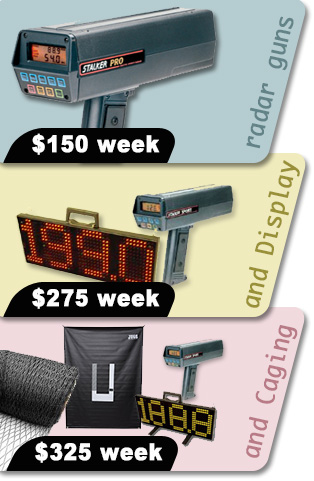
Mody Company Creative
Tom Mody
888-828-6639
tom@modycompany.com
5682 Granollers Dr
Las Vegas NV 89135
Shipping to You!
Tennis Serve Speed Applications
Tennis serve applications fall to generally 2 categories. The first being promotion use in a confined environment. The second being on-court applications for tournaments.
Promotion Use
Promotions at tennis tournaments or trade shows can enjoy the crowd interaction of speed serve cages. It's very exciting for a fan or recreational player to test their best serve with the Pros. Our general units should function perfectly for this type of application. The biggest problem is filtering out racquet head speed. There are 2 ways to accomplish this. The first is setting the low cut filter to read only speeds above 50 MPH. Secondly would be to set the radar unit in a trigger mode. Most units come with 2 modes, continuous and trigger. Continuous mode has the radar signal transmitting at all times it may first lock on the racquet instead of the ball. The trigger mode transmits only when the trigger is pressed and locks the first speed read. To filter out the racquet press the trigger at the moment of contact between the ball and the racquet. This way the initial racquet speed will not be timed since the radar isn't transmitting until you activate it. Cage design B will be utilized for a confined environment because it has appropriate head clearance for the racquet swing.
On-Court Tournaments
Timing on a court during a match is not as simple as point and click. The radar unit must be able to filter out racquet head motion and motion of the ball in play. Filtering features need to have a low cut off point at a very high setting. So potentially the radar will not pick up any speeds below 50 MPH. Another problem is reset time between first and second serves. When in continuous mode the radar units will read a speed and reset the unit to "000" after a few seconds. If the first service is a fault the unit may reset during the second serve motion thus disturbing the player. The top end units have control over the reset time so you can adjust it a bit quicker. Though in continuous modes the units can run unattended, it's best to have the unit run manually in trigger mode. This way the units transmission is controlled by the operator and the worry or reset interference or in ball play timing is eliminated. Serves down the "T" are most accurate as they are in a straight line with the radar. Wide serves may actually register a bit slower than their actual speed due to the angle.
NOTE: We currently do not have units available to run 2 displays from 1 gun.







